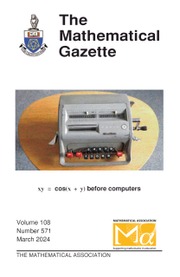No CrossRef data available.
Article contents
Row sums conjecture in iterated Rascal triangles
Published online by Cambridge University Press: 15 October 2025
Extract
A Rascal triangle is a Pascal-type numeric triangle developed in 2010 by three middle-school students, Alif Anggoro, Eddy Liu and Angus Tulloch [1]. During their mathematics classes they were challenged to provide the next row for the following sequence: The expected answer was the one that matches Pascal’s triangle, i.e. 1 4 6 4 1, obtained by applying the recurrence rule of binomial coefficients South = East + West. Instead, the young students suggested that the next row should be 1 4 5 4 1. In contrast to Pascal’s triangle rule South = East + West, they produced the new row using the relation they called the diamond formula
The expected answer was the one that matches Pascal’s triangle, i.e. 1 4 6 4 1, obtained by applying the recurrence rule of binomial coefficients South = East + West. Instead, the young students suggested that the next row should be 1 4 5 4 1. In contrast to Pascal’s triangle rule South = East + West, they produced the new row using the relation they called the diamond formula By applying the diamond formula (1), the students produced an original triangular sequence known as the Rascal triangle, see Table 1.
By applying the diamond formula (1), the students produced an original triangular sequence known as the Rascal triangle, see Table 1.
Information
- Type
- Articles
- Information
- Copyright
- © The Authors, 2025 Published by Cambridge University Press on behalf of The Mathematical Association


